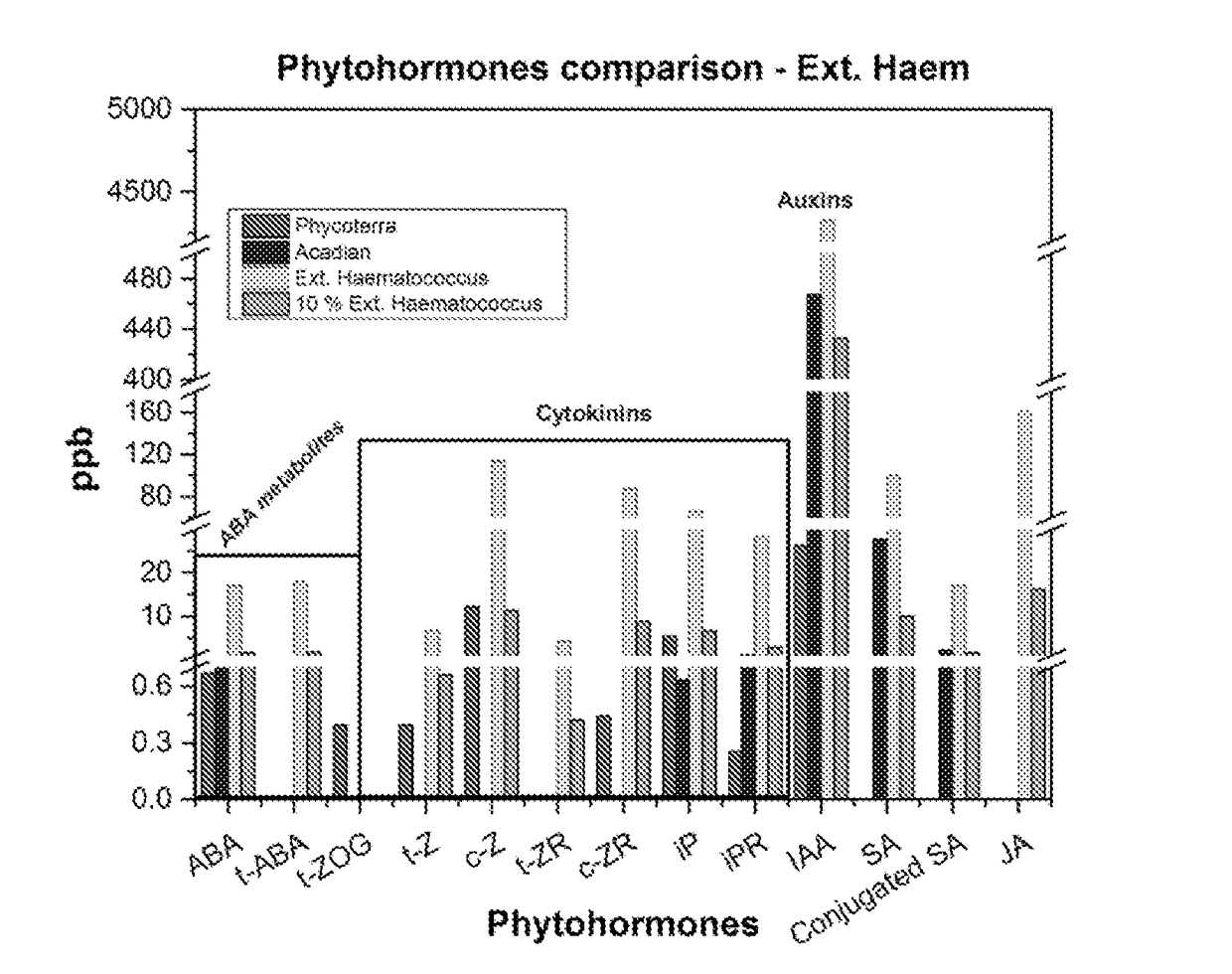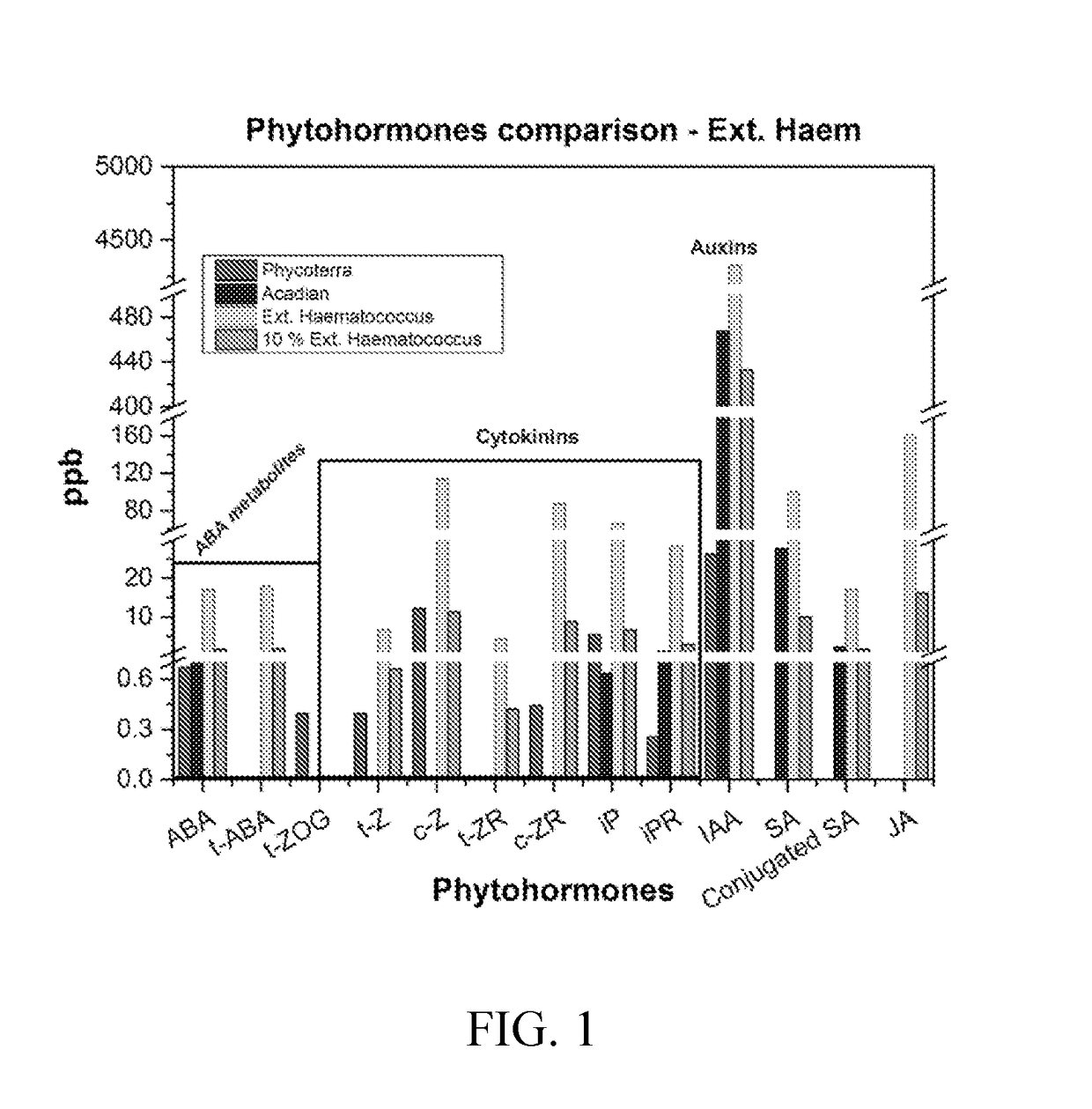Haematococcus based compositions for plants and methods of application
a technology of compositions and haematococcus, applied in the field of haematococcus based compositions for plants and methods of application, can solve the problems of increasing the bound water content of polysaccharides, affecting the emergence and yield of plants, and not maintaining whole cells in a viable sta
- Summary
- Abstract
- Description
- Claims
- Application Information
AI Technical Summary
Benefits of technology
Problems solved by technology
Method used
Image
Examples
example 1
[0115]An experiment was conducted to determine if application of a low concentration of a Haematococcus based composition to tomato seeds planted in soil affected the rate at which the seedlings emerge from the soil. Tomatoes are part of the Solanaceae family. Tomato seeds (Solanum lycopersicum) were planted in trays with standard soilless plant potting soil mix. Ten treatments were compared to an untreated control (UTC) and are listed in Table 2. The Haematococcus pluvialis extracted biomass was mechanically lysed before being subjected to a supercritical carbon dioxide extraction process. A commercially available macroalgae extract based product was obtained from Acadian Seaplants Limited (30 Brown Avenue, Dartmouth, Nova Scotia, Canada, B3B 1X8) for comparison. The commercially available product Transit Soil from FBSciences, Inc. (153 N Main Street, Ste 100, Collierville, Tenn. 38017) was also tested.
TABLE 2TreatmentNo.Treatment Description1UTC—untreated water check2Phototrophic ...
example 2
[0123]An experiment was conducted to determine if a low concentration and low frequency application of a Haematococcus based composition to bell pepper plants by soil application affected the yield of the plants. Bell pepper (Capsicum annuum) are part of the Solanaceae plant family and seeds were planted in a field in Ventura County, Calif. Two treatments were compared to an untreated control (UTC) and are listed in Table 7. A commercially available macroalgae extract based product was obtained from Acadian Seaplants Limited (30 Brown Avenue, Dartmouth, Nova Scotia, Canada, B3B 1X8) for comparison.
TABLE 7Treatment No.Treatment Description1UTC—untreated water check2Phototrophic Haematococcus extracted biomassplus Kappaphycus liquid extract3Grower Standard Product—Acadian Liquid SeaweedConcentrate
[0124]The Haematococcus based composition was pasteurized, normalized to 10% solids and 10% volume of Kappaphycus liquid extract), and stabilized with phosphoric acid (H3PO4) and potassium so...
example 3
[0127]An experiment was conducted to determine if a low concentration and low frequency application of Haematococcus based composition to bell pepper plants (Capsicum annuum) by foliar application affected the yield of the plants. The foliar trial occurred in the same location, with the same treatments, and with the same design as the experiment of Example 2.
[0128]The Haematococcus based composition was applied at a low concentration of 7 mL / gallon. The tested concentration of 7 mL / gallon diluted the composition which originally contained 10% solids by weight of Haematococcus cells to the low percent solids content of only 0.018492% (or 0.018492 g of microalgae cells / 100 mL of water). The Acadian treatment was applied at a concentration of 18.9 mL / gallon. Five total treatments were applied at a low frequency (i.e., averaging about 21 days between applications), starting three weeks after plant establishment. The treatments occurred with 20 days between the first and second, 23 days ...
PUM
| Property | Measurement | Unit |
|---|---|---|
| temperature | aaaaa | aaaaa |
| temperature | aaaaa | aaaaa |
| temperature | aaaaa | aaaaa |
Abstract
Description
Claims
Application Information
 Login to View More
Login to View More - R&D
- Intellectual Property
- Life Sciences
- Materials
- Tech Scout
- Unparalleled Data Quality
- Higher Quality Content
- 60% Fewer Hallucinations
Browse by: Latest US Patents, China's latest patents, Technical Efficacy Thesaurus, Application Domain, Technology Topic, Popular Technical Reports.
© 2025 PatSnap. All rights reserved.Legal|Privacy policy|Modern Slavery Act Transparency Statement|Sitemap|About US| Contact US: help@patsnap.com


